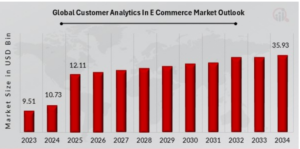Table of Contents
- The Growing Importance of Customer Analytics in E-commerce
- How Data-Driven Insights Drive Smarter Decisions
2. What is Customer Analytics and Why Data Matters
- Definition and Key Components
- Techniques Used: Data Mining, Predictive Modeling, and Segmentation
3. Benefits of Customer Analytics
- Marketing Optimization
- Reducing Customer Churn
- Increasing Conversion Rates
4. Key Customer Analytics Strategies for E-commerce Growth
- Personalization through Data
- Predictive Customer Analytics for Demand Forecasting
- Data-backed Pricing and Promotions
5. Tools for Customer Analytics in E-commerce
6. Real-World Applications of Customer Analytics
- Case Study: Boosting Sales Through Data-Driven Promotions
In today’s e-commerce business, customer analytics is no longer an option; it’s a necessity. It helps businesses make data-driven decisions and personalize customer experiences. From optimizing marketing campaigns and revenue to reducing churn, customer analytics is the way to stay ahead in the competitive market.
Customer data is the backbone of a successful e-commerce business. Their preferences, behavior, and satisfaction levels directly influence growth and profitability. Today, customers not only expect quality products, but they also want brands to understand their personal needs.
But how can businesses truly know what their customers are looking for?
This is where customer analytics comes into play. By analyzing purchase data, browsing behavior, transactions, and interactions, businesses can uncover hidden patterns and predict what a customer is looking for. This helps businesses to make smarter decisions and deliver the needs of customers appropriately.
Customer analytics in e-commerce market size was estimated at 10.73 (USD Billion) in 2024. It is expected to grow from 12.11 (USD Billion) in 2025 to 35.93 (USD Billion) by 2034.
In this blog, we will explore the importance and key benefits of customer analytics and the key customer analytics strategies for e-commerce growth.

What is customer analytics and why data matters
Customer analytics is the process of collecting data from various sources (demographics, behavioral, transactional) to get a clear understanding of customer’s needs, preferences, and behaviour. This helps helping businesses to improve products, services, and customer experiences.
Several techniques are used such as, data mining, predictive modeling, and segmentation, which help businesses to understand different patterns and trends to understand customers better. These data-driven insights provide a better understanding of customer needs helping businesses fulfil the ever-changing demands of customers.
Benefits of Customer Analytics
- Marketing optimization
Customer analytics optimizes marketing campaigns effectively. It helps identify which campaign worked the best. Some of the key metrics to track marketing campaigns are conversion rates, click-through rates (CTR), and return on ad spend (ROAS). Analyzing customer acquisition costs (CAC) and customer lifetime value (CLV) also reveals the true impact of your campaigns.Besides tracking performance, customer analytics helps businesses spot new opportunities by identifying shopping patterns and preferences. - Reduce customer churn
Retaining customers is the key to create revenue. According to few studies, 80% of future revenue will stem from just 20% of your existing customers. Customer analytics helps in identifying the loyal customers by identifying their purchase history, spends etc. For example, certain customers might respond to specific promotions, or they constantly buy highly valuable items.By recognizing these trends businesses can tailor their marketing efforts such personalizing recommendation, discounts etc. to meet their needs. This will improve customer satisfaction, making them more likely to stay with your brand, which reduces churn. - Increased conversion rates
Conversion rate is the percentage of people visiting your website to make a desired action, like purchasing a product or adding something to the cart. Customer analytics play a major role in understanding users’ behavior, like where they drop off, which pages they spend time on, or what products they view. With these insights, businesses can make data-driven changes to improve their website design, to simplify the payment process or add clear call-to-action buttons to boost conversions.
Key Customer Analytics Strategies for E-commerce Growth
Personalization
E-commerce platforms use customer data to provide a personalized experience by suggesting relevant products. Businesses can use customer analytics to identify customers past purchases, browsing patterns, search queries, etc. Based on these factors, businesses can deliver personalized and complementary products, and promotional emails, thus boosting customer engagement.
Predictive customer analytics for growth
Predictive customer analytics helps businesses forecast demand by analyzing customer past purchase patterns, browsing histories, etc. This helps businesses to stock in-demand items at the right time. For example, when there is a hike in laptop sales, as schools re-open, e-commerce platform can stock more laptops and provide deals on accessories like backpacks, bottles, etc.
Additionally, predictive customer analytics helps in identifying current trends, like popular products or emerging buying patterns.
Data-backed Pricing and Promotions:
Pricing and promotions based on data help companies boost their revenue. This approach uses real-time insights about customers to tweak product prices. Take an online store as an example. If it spots a jump in demand for a specific item, it might increase the price a bit to maximize profit.
Similarly, when shoppers add stuff to their carts but don’t seem ready to buy, the store can send them special deals to encourage them to finish their purchase. This helps to cut down on people leaving items in their carts without buying.
Tools for Customer Analytics in E-commerce
Some of the tools for customer analytics in e-commerce are,
- Google Analytics – Monitors site visitors, user details, and sales.
- Adobe Analytics – Provides in-depth user grouping and customer path insights.
- Mixpanel – Examines live user actions and behavior patterns.
- HubSpot – Customer management system with built-in tools to group users and run campaigns.
- Tableau – Shows customer data in easy-to-use charts.
- Power BI – Builds detailed customer reports and visual representations.
Real-World Applications example of customer analytics
An e-commerce platform serving over 800 million customers struggled to boost sales despite heavy investments in promotions. The company’s promotional efforts like discounts, mobile promotions, and lucky draws, failed to significantly impact sales or customer engagement.
For a solution, the company reached out to Prescience Decision Solutions, a Movate company, where the team examined factors like purchase history, pricing sensitivity, and location. Through customer analytics, they segmented the customers. They used a targeting and positioning model, and further divided the customers into 5 segments. A promotional strategy was made based on key metrics (KPIs) like shopper reach and seasonal lift.
The solution was built on AWS Redshift, AWS S3, and python, which helped the company gain higher customer engagement and achieve a 6-10% revenue growth per segment within two months. Customer analytics played a key role by providing deeper insights into buying behavior, enabling the company to create a data-driven and personalized promotion.
To get more insights click here
Conclusion
In today’s e-commerce business, customer analytics is no longer an option; it’s a necessity. It helps businesses make data-driven decisions and personalize customer experiences. From optimizing marketing campaigns and revenue to reducing churn, customer analytics is the way to stay ahead in the competitive market.
At Prescience Decision Solutions, a Movate company, we offer complete data solutions that integrate artificial intelligence and machine learning across various services like analytics, business intelligence, data engineering, and more. We also offer advanced customer analytics solutions that help businesses understand customer behavior, predict trends, and optimize engagement strategies. Through this, businesses can increase customer loyalty, retention and revenue.
Explore our customers success stories here.

Prescience Team



